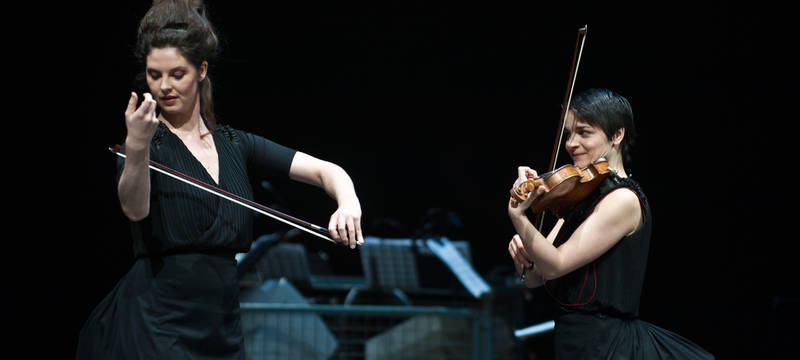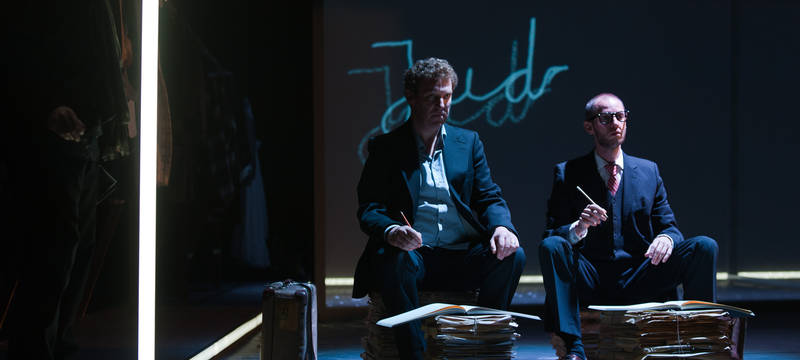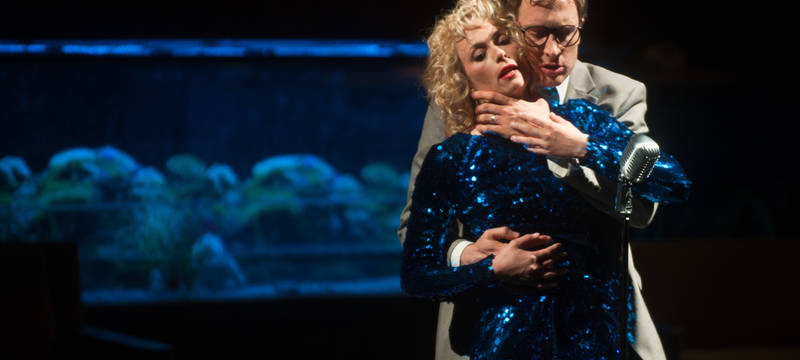The Munich Biennale
The Munich Biennale
International Festival for New Music Theatre
In the history of New Music, the focus was never on opera; opera was more or less marginal. The expressed progress was in other areas of music. The exponents of postwar Modernism, the generation of composers that was born in the 1920s and early 1930s, came rather late to music theater (they were quicker to discover the theater in music). Ligeti wrote his Grand Macabre 1974-77, Helmut Lachenmann did not write his Mädchen mit den Schwefelhölzern (The Girl With the Matches) until 1990-96, Karlheinz Stockhausen worked his way through spatial music and multicultural mysticism to arrive at the theatrical staging surrounding music, a process that began in the 1980s. Pierre Boulez may have probed giant quarries with his composed sound design, but he did not write operas, he only conducted them. Luigi Nono was the exception in this circle of avant-gardists; his work Intolleranza dealt with politics. Hans Werner Henze was one of the few from this generation who did not avoid opera as a traditional art form and performance venue – on the contrary, he made use of the opera, because he did not think it was a reactionary institution per se.
Henze knew from his own experience that the relative distance between opera and avant-garde is based on reciprocity, and that internationally something akin to a laboratory was missing, a laboratory which would open up the realms of theater to young composers and allow them to conduct experiments and trials and exchange ideas with their older colleagues. There were electronic studios at the music schools, universities and radio stations. The IRCAM in Paris was involved in "recherche et cooperation acoustique/musique," including the combination of traditional and electronic instruments. But where was the new music theater?
Knowledge and interests worked in a unique way to create the Munich Biennale. Hans Werner Henze: "The whole story started with a query from the departmental head of the (Munich) cultural office … whether I … would be interested in considering creating some sort of civic music festival in Munich. After a period of time I suggested organizing something that had been lacking up until that point, something that also did not exist anywhere else in the world and yet was an urgent necessity – namely, a place where the young generation of composers interested in theater ... could realize their ideas." And so the Munich Biennale was born. The first International Festival of New Music Theater took place in 1988. Adriana Hölszky, the Bucharest composer who has lived in Germany since 1976, participated in the first festival with her piece Bremer Freiheit (Bremen Freedom), an opera based on Rainer Werner Fassbinder's drama about Geesche Gottfried, who was convicted of murder by poisoning and hanged in Bremen in 1831. This was Hölszky's first music theater piece. The opera has been performed more than forty times in the meantime, at the state theaters in Stuttgart and Bremen, at festivals in Vienna, Wiesbaden and Helsinki – a success story similar to the success of Gerd Kühr's Stallerhof. Detlev Glanert's first opera Leyla and Medjnun opened the festival; the opera is based on an ancient Persian fairy tale about poetic love, insanity, and death. Mark-Anthony Turnage's Greek rounded out the series of premieres – in the meantime, the work has been performed over sixty times in Germany, Great Britain, Italy, the Netherlands, Australia and the United States.
These were operas whose libretti were based on poems and dramas from ancient and modern times, from European and from distant cultures. They examined true stories and provided myths and fantasies with sounds. The genre of the literary opera remained a distinguishing feature of Henze's era, the first five festivals of the Munich Biennale. There followed the world premieres in 1990: András Hamary based his opera Seid still (Be quiet) on a novella by his fellow countryman István Örkény; Wolfgang von Schweinitz based his piece Patmos on the Revelation of St. John; Hans-Jürgen von Bose's 63: Dream Palace is based on a novella by James Purdy ("… I felt as if this story ... had been waiting for me"). New to the second Biennale program was puppet theater, an old, popular European tradition – and simultaneously a bridge to Far Eastern cultures. And this was also a piece of the genius loci, which Karl Amadeus Hartmann once defended against the accusations of the conservatives. The rebels in the literature scene in Munich during the early part of the 20th century appreciated the special subtleties of intimate plays as a medium of criticism. This resulted in a significant expansion of the network of events the Biennale had to offer.
Since the festival was founded, the opera performances have been supplemented by discussions with the composers before the premieres, and the operas have been accompanied by concerts and enhanced by symposiums. This interlinking of performances and reflections on the arts of our time – the status of this interlinking is critical, in the double meaning of the word – is part of the elementary philosophy of the Munich Biennale, and also part of the internationalism of its program and impact. The festival does not restrict its focus to Europe. Since celebrating their world premieres during the Third Munich Biennale, the operas of the Rumanian composer Violeta Dinescu (Eréndira), the Indian Param Vir (Snatched by the Gods; Broken Strings) and the Italian Giorgio Battistelli (Teorema) have been performed over twenty times on stages in Germany, England, Italy and Austria. Benedict Mason's opera about soccer, Playing Away, enchanted the Munich genius loci in 1994 in a unique manner; it was performed several times in the birthplace of this sport after the Biennale.
The Fourth Munich Biennale in 1994 was Hans Werner Henze's last festival as artistic director. In 1996, he passed the baton to Peter Ruzicka. These two artists and art patrons practiced what one can learn from the classic composer of 20th-century opera, Alban Berg: the art of transition. They directed and organized the Fifth Biennale together. They realized a new concept. The festival program was no longer restricted to a short time period in late spring – it was spread out over three periods of performances, and each period lasted ten to twelve days. Thus eight new music theater works celebrated their premieres, including the Marco Polo opera by the Chinese composer Tan Dun, a cross-cultural polystylistic work and a "sound history" of the relationships between Europe and Asia, Helmut Oehring's D'Amato System, and Moritz Eggert's Helle Nächte (Bright Nights) – works that also established a connection to the ancient traditions of philosophy, storytelling and performing music, and thus they examined our present-day society of self-involvement.
Peter Ruzicka was predestined to be Hans Werner Henze's successor. A composer himself, as the head of the Radio Symphonie Orchester Berlin and the Hamburgische Staatsoper he acquired the conceptual and administrative experience and international acclaim required to be the artistic director of an innovative festival. He assigned each Biennale a motto. The first sequence of the Sixth Munich Biennale was dedicated to the Dialogue of Cultures – a continuation of the scope of ideas from 1996. The Japanese composer Toshio Hosokawa brought his Vision of Lear to the stage; Tadashi Suzuki wrote the libretto and also directed the production. In Ramanujan, Sandeep Bhagwati induced a collision of the Eastern and Western worlds of theater and lifestyles. Jan Müller-Wieland composed Garcia Lorca's Komödie ohne Titel (An Untitled Comedy). … How Time Flies … was the motto for the second sequence of the Sixth Biennale in the spring of 1999. The title Babette Koblenz gave her opera is a reference to perhaps the most famous novel about time: with her work Recherche (Research), she wanted to "immerse into and research the stream of time, in order to rescue past reality from oblivion and thus send a signal against transience." Vladimir Tarnopolski designed his opera, Wenn die Zeit über die Ufer tritt (When Time Overflows), as a walk though the past and present into the future, as a trilogy of remembering, experiencing and expecting, as an exposition of different areas of the intellect and art forms. The accompanying symposium dealt with the philosophical and aesthetic aspects of this subject. The Biennale concerts brought together works based on the themes of time and eternity, the passing of time and the effusion of time.
In 2000, the publicized reductions in budgets for the arts all over the globe forced the Biennale to return to its old cycle of performances, when every two years Munich is the center of the music theater world for two weeks. Über Grenzen (Crossing Borders) was the motto of the festival as a new era was dawning – the bridge leading from one millennium to the next. Crossing Borders describes an aspect of art that existed even before modern times; the artists of the Romanesque movement found the trenches between the genres to be cumbersome and they simply filled them up. But Crossing Borders also signifies traversing interlocking experiences and climbing over walls and ramparts, which in the end are a burden even for us in regard to our relationship to history. The Israeli composer Chaya Czernowin called her opera Pnima … ins Innere (Pnima ... Inside), which she described as a musical journey through the soul. Claus-Steffen Mahnkopf used Walter Benjamin's "Ninth Theory of History" as a starting point for his considerations on what a new opera could be – this approach, as we can see with the Biennale 2004, inspired and moved other composers as well.
A train of thought can be traced from the Biennale 1996 to the Biennale 1998 and to the Seventh Biennale in the year 2000; the mottoes crystallized the demand for a New Modernism, where it could be possible to solve, in part, the aporias of Postmodernism. The Biennale 2002 took another decisive step in this direction. It incorporated virtual reality, or in other words, what new media and the speed in which new media are changing bring to our lives – as an opportunity, as an irritation, and also as a downright agitation of the archaic. It is part of the fundamental experiences of the arts in the 20th century that the more energetically we stride toward our future, the more we will be confronted with our foundations and with our earliest history. This concept has always been present in the opera genre. The material of operas often centers on old fairy tales and myths, regardless of which culture they originated in. The future prospects of the Munich Biennale – today as in 1988, when Hans Werner Henze opened the first Festival of New Music Theater – lie in this combination of unlocking the door leading to the new and remembering what determines dignity and a civilized life.




